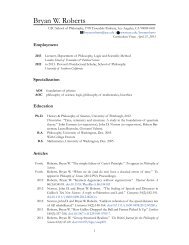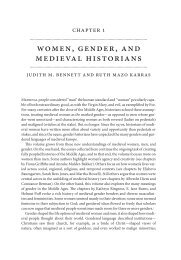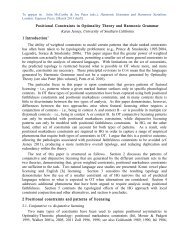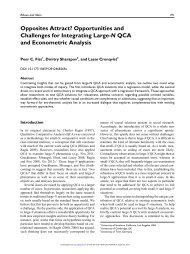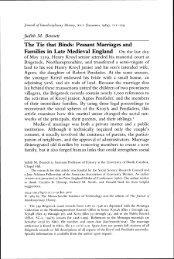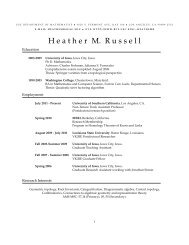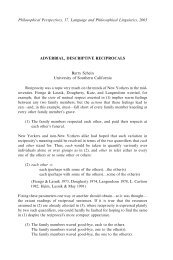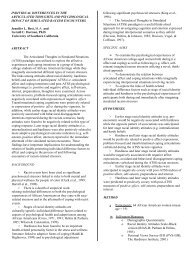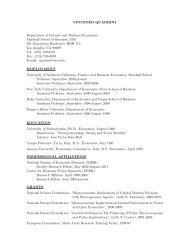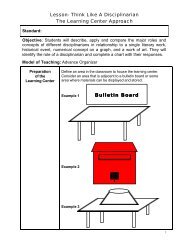Shieva Kleinschmidt [This version differs from the Phil Studies ... - Usc
Shieva Kleinschmidt [This version differs from the Phil Studies ... - Usc
Shieva Kleinschmidt [This version differs from the Phil Studies ... - Usc
Create successful ePaper yourself
Turn your PDF publications into a flip-book with our unique Google optimized e-Paper software.
help: <strong>the</strong> colocation of <strong>the</strong> statue and <strong>the</strong> bronze would remain problematic even if <strong>the</strong><br />
bronze were a portion of stuff ra<strong>the</strong>r than a thing. The stuff view, in fact, seems to<br />
presuppose a third view of when co-location is problematic, namely <strong>the</strong> view that two<br />
entities exactly occupying <strong>the</strong> same region is problematic whenever <strong>the</strong> entities are of <strong>the</strong><br />
same fundamental ontological category (thing, stuff, plurality, etc.), but not when <strong>the</strong>y are<br />
of differing ontological categories. Proponents of this view take problematic colocation<br />
to occur when and only when two material entities of <strong>the</strong> same fundamental ontological<br />
category exactly occupy <strong>the</strong> same region. 10 The idea is that this is <strong>the</strong> kind of colocation<br />
common-sense takes issue with. Two things, like a tabletop and a mirror, won’t share <strong>the</strong><br />
same region. But a thing and <strong>the</strong> matter it’s made of not only will share a region, <strong>the</strong>y<br />
must. The special relation that stands between <strong>the</strong>m, <strong>the</strong> relation of constitution, allows<br />
(and even requires) that its relata are in exactly <strong>the</strong> same region. 11<br />
There is a final possible view about when colocation is problematic: it is<br />
problematic when and only when both entities in <strong>the</strong> region are things. <strong>This</strong> claim, if<br />
defended, would be a successful response to <strong>the</strong> problems I raise in §3, where I claim that<br />
<strong>the</strong> proponent of a stuff solution must avoid colocation of portions of stuff. However,<br />
this view is unsatisfying: why would be problematic for two material things to exactly<br />
10 Some, like David Wiggins, even define colocation to reflect this. That is, x and y are colocated iff (i) x<br />
and y are both material, (ii) x is not identical to y, (iii) x and y are of <strong>the</strong> same ontological category, and (iv)<br />
<strong>the</strong>re is a region, r, such that any subregion of r is occupied by both x and y, and <strong>the</strong>re is no region not<br />
within r which is occupied by ei<strong>the</strong>r x or y. (Based on <strong>the</strong> account presented by David Wiggins in “On<br />
Being in <strong>the</strong> Same Place at <strong>the</strong> Same Time,” p. 5 in Rea 1997. By his account, colocation (which he calls<br />
‘coincidence’) occurs when “two things of <strong>the</strong> same kind (that is, . . . which satisfy <strong>the</strong> same sortal or<br />
substance concept) . . . occupy exactly <strong>the</strong> same volume at exactly <strong>the</strong> same time.”) There are o<strong>the</strong>r<br />
definitions of colocation as well, however, such as a sharing of all spatial and temporal parts (Simons,<br />
Parts: A Study in Ontology, p. 210). The difference between <strong>the</strong>se two definitions seems to be that <strong>the</strong> first<br />
allows two entities to exactly occupy <strong>the</strong> same region without being colocated if <strong>the</strong>y are of different<br />
ontological kinds, whereas <strong>the</strong> second does not (ano<strong>the</strong>r difference between <strong>the</strong> accounts arises when one<br />
denies DAUP). Also, what <strong>the</strong> relevant ontological kinds are <strong>differs</strong> across sources – that stuff and thing<br />
are (at least some of <strong>the</strong>) relevant kinds needs to be defended by <strong>the</strong> proponent of this solution.<br />
11 Obviously, fur<strong>the</strong>r defence of this view of colocation is needed. For instance, <strong>the</strong> appeal to constitution<br />
is problematic. In much of <strong>the</strong> literature, ‘constitution’ is not used in <strong>the</strong> sense in which I will be using it in<br />
this paper. Thus <strong>the</strong>re is a potential response with which someone can say that constitution, on <strong>the</strong>ir<br />
account, requires distinct entities of <strong>the</strong> same ontological category to be exactly located in <strong>the</strong> same region.<br />
Insofar as <strong>the</strong>ir account begs <strong>the</strong> question, perhaps <strong>the</strong> same can be said for <strong>the</strong> stuff <strong>the</strong>orist’s appeal to<br />
constitution as allowing things and stuff to unproblematically exactly occupy <strong>the</strong> same regions.<br />
Also, I do not intend to give <strong>the</strong> impression that I have given an exhaustive list of views about when<br />
colocation is problematic. One I didn’t include, for instance, is <strong>the</strong> view that events can be colocated, but<br />
entities that are “more paradigmatically material” cannot.



